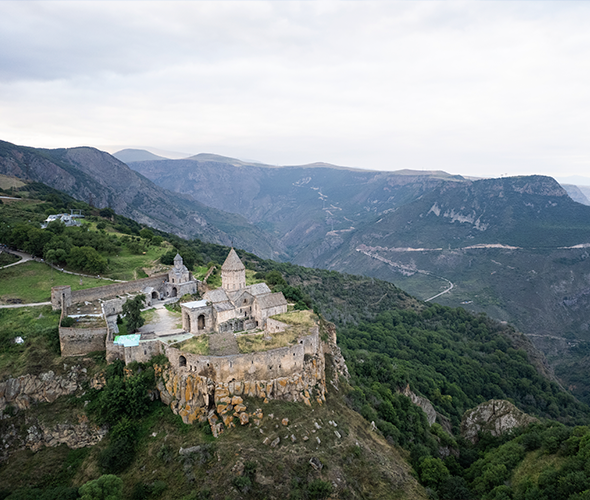Khndzoresk Cave Village
Region
Syunik
Distance from Yerevan
250.3 km
Type
Cave
About 13 kilometers southeast of Goris, on the mountainous slopes at the northeastern edge of the village of Khndzoresk, lies the historic settlement known as Old Khndzoresk. In its early stages, the homes in Khndzoresk were mainly cave dwellings, sometimes located 20–30 meters above the ground. These cave-houses were used not only for living but also for defensive purposes. Over time, stone houses were built in front of the caves, arranged in a terraced fashion—so that the courtyard of the upper house served as the roof of the lower one. One of the most notable monuments of Khndzoresk is the fortress, which served as the military base of Mkhitar Sparapet between 1728 and 1730. Over different periods, four churches were built in the village, of which St. Thaddeus (17th–18th centuries) and St. Hripsime (1666) remain standing. The latter is a three-nave basilica. Though now ruined, the Anapat Church once served as a center for manuscript copying and preservation. Mkhitar Sparapet is buried in the courtyard of this church. Numerous springs have been preserved in the area, many of which are named after their builders—for example, Ghandunts nov, Telunts, and others. Khndzoresk is also home to the palace of Melik Khaso (built in 1836), and near the Church of St. Thaddeus, a rock-carved reservoir has been preserved. During the Soviet era, when the need arose to build new housing, residents began dismantling the old structures, using the stones to construct the new village. This caused significant damage to the historical and cultural landscape that had been preserved until then. In 2012, a 160-meter-long and 63-meter-high suspension bridge was opened in Khndzoresk. It connects the two sides of Old Khndzoresk’s gorge—Ghandunts nov and the Nerkin tagh (Lower District). Valuable information about Khndzoresk is provided by Stepanos Orbelian in his historical work “History of the Province of Syunik.

Interesting
facts about Khndzoresk Cave Village


Facts
Weather in Syunik
The high season in Armenia lasts for a long time due to the pleasant climate conditions. Warm days in Armenia start in March and last until late autumn; winter is usually snowless and not long. The high precipitation season is variable. The tourist season for Khndzoresk cave village depends on the weather conditions.








.png)





